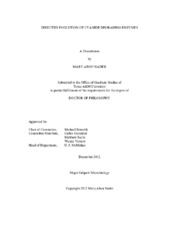| dc.description.abstract | Cyanide is acutely toxic to the environment. However, this simple nitrile is used in several industrial applications especially the mining industry. Due to its high affinity to metals, cyanide has been used for years to extract gold and other precious metals from the ore. Cyanide nitrilases are considered for the detoxification of the industrial wastewaters contaminated with cyanide. Their application in cyanide remediation promises cheaper and safer processes compared to chemical detoxification. However, application of these enzymes in industry requires improving their characteristics.
The goal of this dissertation is to better understand cyanide nitrilases, in particular the cyanide dihydratase from of Bacillus pumilus and Pseudomonas stutzeri and to improve their activity and stability. The lack of any high resolution structure of these enzymes calls for isolating or screening for mutants showing enhancement in enzyme properties.
Described first is a simple and efficient method utilizing in vivo recombination to create recombinant libraries incorporating the products of PCR amplification. This method is useful for generating large pools of randomly mutagenized clones after error-prone PCR mutagenesis. Several parameters were investigated to optimize this technique; length of homology region, vector treatment, induction time and ratio of fragment to vector.
Using error-prone PCR for random mutagenesis, several CynDpum mutants were isolated for higher catalysis at pH 7.7. Three point mutations, K93R, D172N and E327K increased the enzyme’s thermostability. The D172N mutation also increased the affinity of the enzyme for its substrate at pH 7.7 suggesting an effect on the active site. However, the A202T mutation located in the dimerization or the A surface rendered the enzyme inactive by destabilizing it. No significant effect on activity at alkaline pH was observed for any of the purified mutants.
Lastly, an important region for CynDstut activity was identified in the C-terminus. This same region increased the stability of CynDpum compared to the wild-type enzyme. Also, CynDpum-stut hybrid was found to be highly more stable than CynDpum. This same hybrid exhibited 100% activity at pH9, a pH where the parent enzyme is inactive, and retained 40% of its activity at pH 9.5 making it a true pH tolerant mutant. | en |


